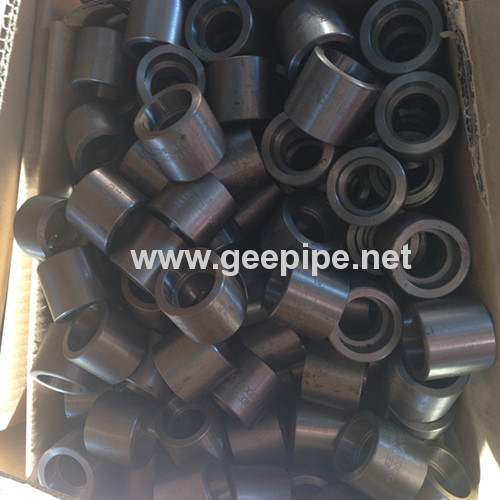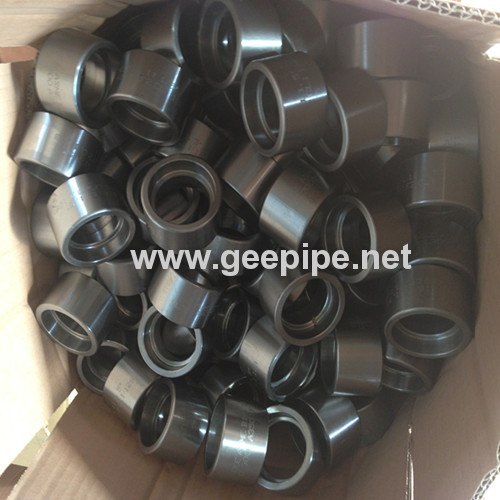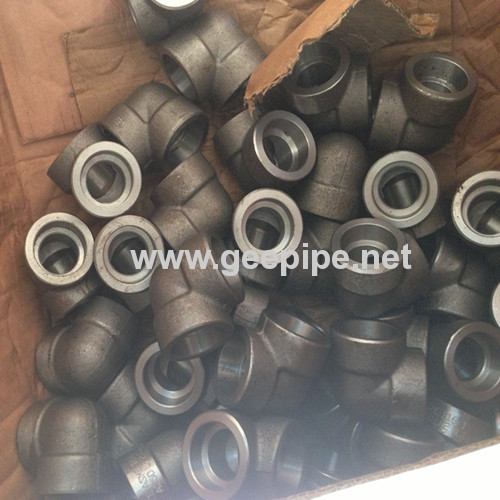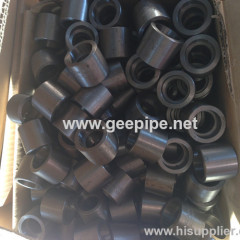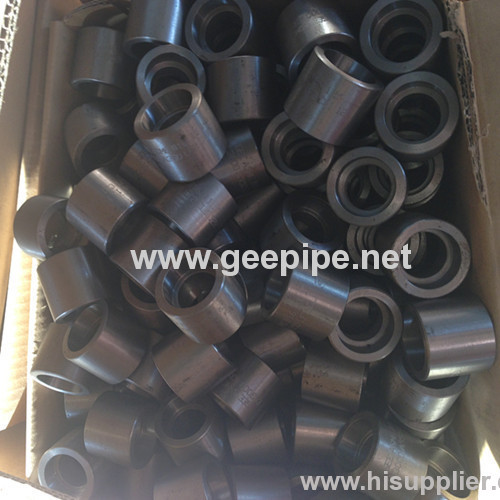DN :6 ,8,10,15,20,25,32,40,50,65,80,.100
NPS:1/8",1/4",3/8",1/2",3/4",1'
pressure;3000lb
high pressure and good quality
ASTM Grades
Dimensions, dimensional tolerances et cetera from wrought carbon and alloy steel fittings are defined in several ASME standards. The material qualities for these fittings are defined in the ASTM standards.
These ASTM standards, define the specific manufacturing process of the material and determine the exact chemical composition of pipes, fittings and flanges, through percentages of the permitted quantities of carbon, magnesium, nickel etc., and are indicated by "Grade".
For example, a buttweld carbon steel fitting can be identified with Grade WPA or WPB, a buttweld stainless-steel fitting with Grade WP304 or Grade WP321 etc..
Below you will find as an example a table with chemical requirements for fittings ASTM A403 Grade WP304, WP304L, WP316L and a table with frequent Grades, arranged on pipe and pipe-components, which belong together as a group.
Below you will find as an example a table with chemical requirements for fittings ASTM A403 Grade WP304, WP304L, WP316L and a table with frequent Grades, arranged on pipe and pipe-components, which belong together as a group.
As you may be have noted, in the table below, ASTM A105 has no Grade. Sometimes ASTM A105N is described;
"N" stands not for Grade, but for normalized. Normalizing is a type of heat treatment, applicable to ferrous metals only. The purpose of normalizing is to remove the internal stresses induced by heat treating, casting, forming etc..
"N" stands not for Grade, but for normalized. Normalizing is a type of heat treatment, applicable to ferrous metals only. The purpose of normalizing is to remove the internal stresses induced by heat treating, casting, forming etc..
Chemical requirements composition, %
| Grade F304 (A) | Grade F304L (A) | Grade F316L (A-B) | |
| Carbon, max | 0.08 | 0.035 | 0.035 |
| Manganese, max | 2.00 | 2.00 | 2.00 |
| Phosphorus, max | 0.045 | 0.045 | 0.045 |
| Sulfur, max | 0.030 | 0.030 | 0.030 |
| Silicon, max | 1.00 | 1.00 | 1.00 |
| Nickel | 8 - 11 | 8 - 13 | 10 - 15 |
| Chrome | 18 - 20 | 18 - 20 | 16 - 18 |
| Molybdenum | - | - | 2.00-3.00 |
(A) Carbon 0.040% max. is necessary where many drawing passes are required, as with outside diameter <0.5 inch (12.7 mm), or nominal wall thickness <0.049 inch (1.2 mm).
(B) On pierced tube, Nickel may be 11 - 16.00%.
(B) On pierced tube, Nickel may be 11 - 16.00%.
| ASTM Grades | |||||
| Material | Pipes | Fittings | Flanges | Valves | Bolts & Nuts |
| Carbon Steel | A106 Gr A | A234 Gr WPA | A105 | A216 Gr WCB | A193 Gr B7 A194 Gr 2H |
| A106 Gr B | A234 Gr WPB | A105 | A216 Gr WCB | ||
| A106 Gr C | A234 Gr WPC | A105 | A216 Gr WCB | ||
| Carbon Steel Alloy High-Temp | A335 Gr P1 | A234 Gr WP1 | A182 Gr F1 | A217 Gr WC1 | A193 Gr B7 A194 Gr 2H |
| A335 Gr P11 | A234 Gr WP11 | A182 Gr F11 | A217 Gr WC6 | ||
| A335 Gr P12 | A234 Gr WP12 | A182 Gr F12 | A217 Gr WC6 | ||
| A335 Gr P22 | A234 Gr WP22 | A182 Gr F22 | A217 Gr WC9 | ||
| A335 Gr P5 | A234 Gr WP5 | A182 Gr F5 | A217 Gr C5 | ||
| A335 Gr P9 | A234 Gr WP9 | A182 Gr F9 | A217 Gr C12 | ||
| Carbon Steel Alloy Low-Temp | A333 GR 6 | A420 Gr WPL6 | A350 Gr LF2 | A352 Gr LCB | A320 Gr L7 A194 Gr 7 |
| A333 Gr 3 | A420 Gr WPL3 | A350 Gr LF3 | A352 Gr LC3 | ||
| Austenitic Stainless Steel | A312 Gr TP304 | A403 Gr WP304 | A182 Gr F304 | A182 Gr F304 | A193 Gr B8 A194 Gr 8 |
| A312 Gr TP316 | A403 Gr WP316 | A182 Gr F316 | A182 Gr F316 | ||
| A312 Gr TP321 | A403 Gr WP321 | A182 Gr F321 | A182 Gr F321 | ||
| A312 Gr TP347 | A403 Gr WP347 | A182 Gr F347 | A182 Gr F347 | ||
ASTM Materials
Pipes
- A106 = This specification covers carbon steel pipe for high-temperature service.
- A335 = This specification covers seamless ferritic alloy-steel pipe for high-temperature service.
- A333 = This specification covers wall seamless and welded carbon and alloy steel pipe intended for use at low temperatures.
- A312 = Standard specification for seamless, straight-seam welded, and cold worked welded austenitic stainless steel pipe intended for high-temperature and general corrosive service.
Fittings
- A234 = This specification covers wrought carbon steel and alloy steel fittings of seamless and welded construction.
- A420 = Standard specification for piping fittings of wrought carbon steel and alloy steel for low-temperature service.
- A403 = Standard specification for wrought austenitic stainless steel piping fittings.
Flanges
- A105 = This specification covers standards for forged carbon steel piping components, that is, flanges, fittings, Valves, and similar parts, for use in pressure systems at ambient and higher-temperature service conditions.
- A182 = This specification covers forged or rolled alloy and stainless steel pipe flanges, forged fittings, and Valves and parts for high-temperature service.
- A350 = This specification covers several grades of carbon and low alloy steel forged or ring-rolled flanges, forged fittings and Valves for low-temperature service.
Valves
- A216 = This specification covers carbon steel castings for Valves, flanges, fittings, or other pressure-containing parts for high-temperature service and of quality suitable for assembly with other castings or wrought-steel parts by fusion welding.
- A217 = This specification covers steel castings, martensitic stainless steel and alloys steel castings for Valves, flanges, fittings, and other pressure-containing parts intended primarily for high-temperature and corrosive service.
- A352 = This specification covers steel castings for Valves, flanges, fittings, and other pressure-containing parts intended primarily for low-temperature service.
- A182 = This specification covers forged or rolled alloy and stainless steel pipe flanges, forged fittings, and Valves and parts for high-temperature service.
Bolds & Nuts
- A193 = This specification covers alloy and stainless steel bolting material for pressure vessels, Valves, flanges, and fittings for high temperature or high pressure service, or other special purpose applications.
- A320 = Standard Specification for Alloy-Steel and Stainless Steel Bolting Materials for Low-Temperature Service.
- A194 = Standard specification for nuts in many different material types.
Manufacturing of Butt Weld Fittings
Introduction to Hot Forming
The principal methods of hot working are extrusion, drawing, forging and rolling. Rolling is the most extensive employed forming process, though some limitations may apply to the process. Rolling mainly consists of three major sub-categories: flat rolling, shape rolling (with specifically designed roll grooves) and pipe rolling (including piercing). Forging may be sub-categorized as hamming, pressing, etc.
Forging may be performed under hammers, in mechanical presses and upsetters or by a method known as roll forging. Pressing generally includes the manufacture of forged articles in hydraulic presses. Extrusion usually is performed in hydraulic presses which force the hot steel through a die. Rolling is performed in rolling mills of a variety of types.
The two principal reasons for perform metal forming at elevated temperatures (hot working) are to reduce the forming loads through the reduction of the resistance of the steel to deformation, and to develop preferred metallurgical structures for strength and ductility of the finish products.
The most appropriate manufacturing method of a product will be decided with consideration of its material, sizes, shape, use, standards and other properties.
There are numerous processes for manufacturing butt weld fittings, several examples listed as follows.
There are numerous processes for manufacturing butt weld fittings, several examples listed as follows.
Tees: Extrusion method (Hot Forming)
The hot-extrusion process consists of enclosing a piece of metal, heated to forging temperature, in a chamber called a "container" having a die at one end with an opening of the shape of the desired finished section, and applying pressure to the metal through the opposite end of the container. The metal is forced through the opening, the shape of which it assumes in cross-section, as the metal flows plastically under the great pressures used.
Tees using raw material with a bigger diameter than the finished product, the branch outlet is extruded from pipe while the main body is being pressed. The outlet's wall thickness can also be adjusted as needed. Applied to Tees with large diameters, heavy wall thickness and/or special material with challenging workability that cannot be manufactured using the hydraulic bulge method.
